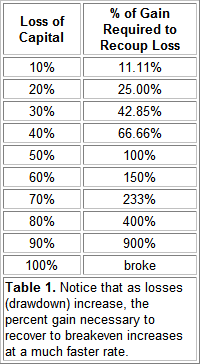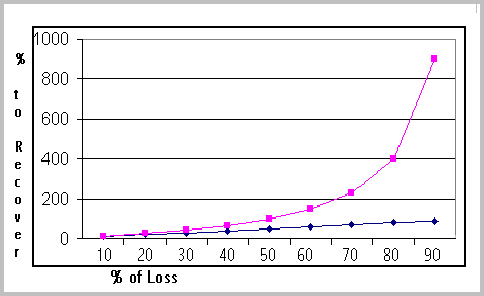Drawdowns: Steps to Take When You Find Yourself in a Hole
Drawdowns are a trader’s worst enemy. None of us is immune. Therefore, in
order to survive, we must take steps to help prevent and minimize them. When
faced with the inevitable, we must then take steps toward recovery.
Background
As mentioned in prior money management articles, drawdown is simply the
amount of money you lose trading expressed as a percentage of your total trading
equity. If all your trades were profitable, you would never experience a
drawdown. It does not measure overall performance, only the money lost while
achieving that performance. Its calculation begins only with a losing trade and
continues as long as the account hits new equity lows. As drawdowns increase,
the percent of gain required to get back to breakeven increases geometrically.
For instance, if you lose 10% of your capital, you must make at least 11.11% on
your remaining capital to get back to breakeven. This is illustrated in the
table below.
Click here to order your copy of The VXX Trend Following Strategy today and be one of the very first traders to utilize these unique strategies. This guidebook will make you a better, more powerful trader.


An Ounce Of Prevention
An ounce of prevention is worth a pound of cure, especially when it comes to
drawdowns. Proper money management which emphasizes the use of protective stops
is crucial. I, and others, have many articles on this subject under Trader’s
Lessons. I strongly urge you to study these. Keep in mind, though, you will
still be exposed to drawdowns even though you implement strict money management.
Therefore, it’s important to recognize what may be causing the drawdown and more
importantly, how to stop and recover from it.
Is It Me?
It’s beyond the scope of this article to cover all the psychological pitfalls
of trading. However, when faced with a drawdown, you should always look first
within yourself to make sure that nothing has recently changed. Ask yourself
general questions like: Have you been doing your homework and managing risks?
Have you changed your trading style on one or a group of trades? If so, is there
a personal reason? Have you recently incurred any major life events? Have you
been well? Are their any distractions that have been keeping you from focusing?
Or The Markets?
Futures Truth once equated a trading system’s performance to dancing to your
favorite song. As long as your song is playing, you seem to float on air.
However, it becomes very difficult to dance when the next, unfamiliar, song
begins to play. In trading, when conditions are favorable to your methodology,
you will be profitable. However, when the environment changes, unless you stop
trading or change your style, you will likely lose money. As an example, the
summer months are notorious for being choppy, as many traders are on vacation.
During these times, momentum-based methods, which depend on prices to persist in
the direction of the trend, tend to under-perform countertrend-based methods.
During these times, the momentum trader should scale back on his trading and/or
become very selective. For me, this means only taking trades with the sector,
the stock and market-timing systems all set up.
If You’re In A Hole, STOP DIGGING!
When faced with a steep drawdown, you must take actions to stop it. The good
news is, stopping a drawdown is not difficult. You simply stop trading. Period.
Recovering
By not being in the markets, you will be able to sit back and analyze the
situation without the emotions that come with market exposure. Make sure you
fully understand all of the reasons that caused your drawdown. Look within
yourself and review your recent trades/trading journal. Once you have identified
the causes, you are ready to begin paper trading. Keep accurate records and time
stamp your “trades.” Or better yet, have someone help you by “taking” your
trades (or use a tracking service). Make sure you add in commissions and a
reasonable amount of slippage.
Once you become profitable in paper trading (and keep in mind that most ARE
profitable in paper trading, as it lacks the emotions associated with having
real money on the line), slowly ease back into trading. Trade at a size that
seems almost inconsequential to you. If this trading is profitable, then slowly
begin to increase your position size. If you once again encounter losses, then
scale back in your trading or go back to paper trading.
Repeat the above process over and over until your trading improves. Keep
personal notes and notes on the market conditions. Learn from the experience so
that you’ll be better equipped to handle the next drawdown.
Summary
Even with the use of strict money management, drawdowns are inevitable.
Therefore, you must take steps to recognize what’s causing them, take steps to
stop them, and then take steps towards recovery.
Dave Landry
is principal of Sentive Trading, a money management firm, and a principal of
Harvest Capital Management. Mr. Landry is the author of two top selling books,
“Dave Landry’s 10 Best Swing Trader Patterns And Strategies” and “Dave Landry On
Swing Trading.” His website is
www.davelandry.com.
